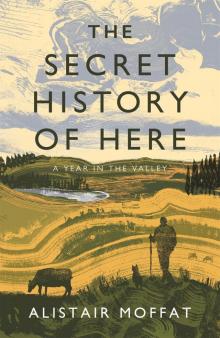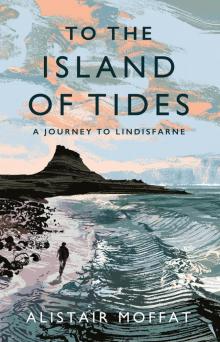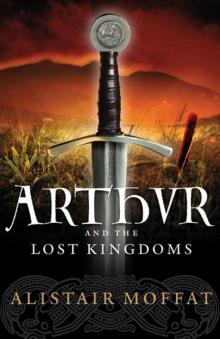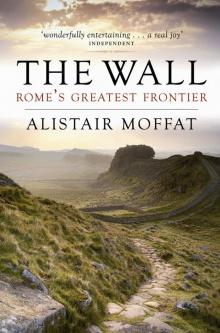- Home
- Alistair Moffat
Britain’s Last Frontier Page 5
Britain’s Last Frontier Read online
Page 5
It may be that the London government and its military planners had the Stuarts’ European supporters, the likes of the fickle French, in mind when they decided to build massive artillery bastions at Ardersier. But, if that were so, then why did the fort’s defences concentrate on the landward side, facing the mountains, rather than the seaward?
The 80 guns mounted along the walls were never once fired in anger but they were effective in another way. As a blunt statement of power, of the absolute determination of the London government to crush any future sedition in the Highlands, Fort George was eloquent. Its barracks could accommodate two field battalions, 2,000 men and officers, and, at 42 acres, it was a large military town. Gaelic speakers called it simply An Gearasdan, ‘The Garrison’.
Fort George was also a focus for another, perhaps more effective, facet of government policy. In the early 18th century, independent companies of soldiers raised from clans loyal to the new dynasty of Hanoverian kings had been deployed to keep order in the Highlands. Their policing duties conferred an enduring name. By 1729, there were six companies and, in Gaelic, they were known as Am Freiceadan Dubh, ‘The Black Watch’. As an excellent night camouflage, they adopted a navy blue, black and dark green sett for their kilts, what was called the government tartan. In 1740, the Black Watch became the 43rd Regiment of the line and in 1745, when Prince Charles was raising the clans in rebellion, they were fighting under the command of the Duke of Cumberland. At the Battle of Fontenoy against the French, near Tournai in the modern-day Belgium close to the border with France, the Black Watch made an impression. When he saw them charge, the commander of the Brigade du Dauphin was shocked at the ‘Highland furies who rushed upon us with more violence than the sea when driven by a tempest’.
As Britain began to see and actively seek opportunities to compile an overseas empire, in the aftermath of Fontenoy and the Seven Years War, the young Prime Minister, William Pitt, believed the army to be desperately short of men. He wrote to the king, seeking to justify the recruitment of men whose chiefs had led them into the charge at Culloden only ten years before: ‘I sought for merit wherever it was to be found. It is my boast that I was the first minister who looked for it and found it in the mountains of the north. I called it forth and drew into your service a hardy and intrepid race of men . . . They served with fidelity as they fought with valour and conquered for you in every part of the world.’
One of the first Highland regiments to fight in North America was the Fraser Highlanders. Raised from his estates by the Master of Lovat, Simon Fraser, whose father of the same name had been executed for treason after the Jacobite Rebellion, they fought under the command of General James Wolfe, another veteran of Culloden. On the Heights of Abraham, near the French town of Quebec, they charged Montcalm’s army and defeated it. But Wolfe’s view of these brave men was cynical:
‘The Highlanders are hardy, intrepid, accustomed to rough country, and it is no great mischief if they fall. How can you better employ a secret enemy than by making his end conducive to the common good?’
Recruitment gathered pace and, as the Highlands emptied of young men, the guns at Fort George looked ever more forlorn, an overblown legacy of fear and suspicion. But the parade ground and the barrack blocks were well used. Between 1756 and 1815 at least 40,000 clansmen, perhaps as many as 75,000, were called to the colours and a large proportion drilled at Fort George. It became the depot of the Seaforth Highlanders and later a base for the Lovat Scouts. After 2007, history came full circle when the very first of many distinguished Highland regiments, the Black Watch, marched through the massive gateway as the new garrison.
Less a symbol of military control, or even a powerful discouragement to rebellion, Fort George became something darker, more sinister. As the glens were emptied and farmsteads abandoned, it was a conduit through which Highlanders passed on their way to win an empire and, in so doing, pay a blood price for rebellion.
2
Land of Mountain and Flood
NO OTHER COUNTRY ON the planet has geology more varied than Scotland’s. Hundreds of millions of years ago, when the Earth was very young and its crust was moving, forming, splintering and reforming vast primordial continents, pieces sometimes broke off. Known as terranes, they drifted across the ancient oceans, pushed on by tectonic forces, and were bulldozed into other landmasses. What became Scotland was welded together from four terranes of very different kinds and ages and their remains and the places where they joined can still be clearly seen.
The oldest of the terranes formed the Western Isles, Coll, Tiree, Iona, the western peninsula of Islay, the Rhinns, and the Atlantic edges of the north-west Highlands, from Cape Wrath to the Kyles of Lochalsh. More than three billion years old, the rocks of these islands and coastlines are made from Lewisian gneiss. Tremendously hard, gneiss was forged deep in the molten crust of the Earth and gradually forced upwards and cooled. Wind, water and ice erosion wore away the rocks that covered it and now outcrops of this beautiful and very ancient stone can be seen all over the Hebrides and the north-west Highlands.
The singular mountain of Suilven is a monument to how dynamic the movement of the surface of the forming continents could be. Along with the glens and mountains of Applecross and Torridon, it is made from thick layers of red sandstone shunted over the Lewisian gneiss by tectonic movement. Geologists believe that these sedimentary rocks were laid down by rivers flowing down from the mountains of a huge palaeocontinent known as Laurentia. Now long fragmented, this vast landmass helped weld together the striking landscape of the Scottish Highlands. Many millions of years ago, other layers were deposited. Durness limestone is thought to be the residue of beach deposits on the coasts of Laurentia.
The line of the Great Glen marks the divide between two terranes and shows the angle at which they collided. To the south lie Dalriadan rocks, mostly strata of sandstone, shale and limestone. They were subjected to violent geological change as volcanoes and Ice Ages moved and moulded them.
The abrupt nature of the Highland Boundary Fault, the Highland Line, makes the collision of two very different terranes abundantly clear. In a remarkable aerial photograph taken by Patricia MacDonald as she flew over Loch Lomond, the fault is obvious. A corrugated, buckled ridge can be seen climbing out of the waters of the loch and up Conic Hill before carrying on through the high moorland to the east. Four small islands lying across the foot of the loch also carry the marks of the ancient drama. North of the buckled ridge is mountainous and immediately to the south green farmland stretches out. Seen from the air, the contrast is startling, abrupt.
When the two terranes were first joined, the mountains to the north-west were very high, as high as the Himalayas are now. The sunken Midland Valley, what Scots call the Central Belt, was originally formed in tropical latitudes. Vast and dense forests grew in swamps and, as they died and fell, layers of organic carbon accumulated. As more trees grew and eventually collapsed into the boggy ground, they compressed the original layers to make seams of coal. In historic times, these would become extremely important. The earliest recorded digging of coal was in the outcrops known as heughs and it was organised by medieval monks at draughty abbeys such as Newbattle near Edinburgh. And, from the 18th century onwards, industrial-scale extraction fuelled the growth of manufacturing in Central Scotland.
Running at approximately the same angle as the Highland Boundary Fault and the Great Glen, the Southern Upland Fault follows a line from Ballantrae in Ayrshire across to Dunbar in East Lothian. The rolling hills of Galloway and the Borders were originally the bed of an ancient ocean and they were planed and smoothed by millions of years of wind, rain and ice.
The final divide between the four terranes that make up Scotland is perhaps the least dramatic but the most informative. On the rocky western coast of the Isle of Man, near the hamlet of Niarbyl, the cliffs of a secluded cove have preserved something unique, the key to a fundamental understanding of the geology and landscape of all Scotland. A thin, greyish
-white seam of rock runs diagonally down to the shore before disappearing below the waves of the Irish Sea. It marks exactly the point at which two gigantic continents collided an unimaginably long time ago and it is the only place on Earth where what is known as the Iapetus Suture can be clearly seen.
Approximately 410 million years ago, a vast prehistoric sea called the Iapetus Ocean was shrinking. It lay between three palaeocontinents – Laurentia, Baltica and Avalonia. The combined terranes of Scotland had been driven towards Laurentia and attached to its southern edge while what was to become England, Wales and southern Ireland lay on the northern shores of Avalonia. As the Iapetus Ocean narrowed and tectonic movement drove Scotland and England inexorably towards each other, they slid together at a particular angle, corrugating the crust of the Earth into high mountains and deep valleys. The north-east to south-west lines of all of the faults, from the Great Glen to the Iapetus Suture, run in the same direction because of the angle of that ancient collision.
The basic shape of Scotland was made when Laurentia was bulldozed into Avalonia and its internal boundaries were defined when the four very different terranes came together. But, 65 million years ago, the Atlantic Ocean did not exist and Scotland and England were attached to North America. And then fire and ice began to move mountains and continents.
A tear appeared in the Earth’s crust and it had the effect of stretching it and making it thinner. As Scotland and England became detached and shifted eastwards, the Atlantic began to fill. Volcanoes erupted, bursting through the surface and a line of them ran from St Kilda to Ailsa Craig in the Firth of Clyde. There exists a very obvious caldera of a huge volcano on the Ardnamurchan peninsula but Skye is the most spectacular example of how fire formed the Highlands. Trotternish was made from old lava fields and the magma formed the jagged ranges of the Black Cuillin on one side and the Red Cuillin on the other.
The ice came much later. A long 2.4-million-year period of Ice Ages has just ended or perhaps only paused. At its maximum extent, the last Ice Age covered Scotland and the north of England completely. Only 15,000 years ago a pitiless white landscape buried and crushed the mountains and glens. In places it could be more than a kilometre thick and nothing and no one could survive in what was a sub-polar climate. Hurricanes roared almost incessantly around the base of vast spherical mountains known as ice-domes and all living things were erased from Scotland.
Ice Ages were probably caused by slight variations in the Earth’s orbit around the Sun. When, at last, it moved back into kilter, some time around 11,000 BC, the weather began to warm and the ice started to melt. This probably happened quickly, over only a few decades. Glaciers moved, cracked and sheared and their massive weight rumbled and scarted over the landscape. Carrying all sorts of rocky debris inside them, the great frozen rivers acted like gigantic earth movers, breaking open water courses, scooping out high corries and deepening valley floors. Because of higher rain- and snowfall, the glaciers were thicker over the Highlands and steeper gradients meant they moved faster and were formidably powerful. Meltwater rivers rushed with such tremendous force that they sometimes flowed uphill and over watershed ridges. For these reasons, the melting ice had more dramatic effects north of the Highland Line, reshaping the landscape and turning many of the river systems so that they ran westwards into the Atlantic.
In the south and east of Scotland and very noticeably in the North-east, the Moray coastlands and the Buchan, the ice had much less impact. In fact, the glaciers delivered benefits as they deposited gravels and mixtures of clay that formed the bedrock of the more fertile soils found in the broadening valleys of what became the Lowlands.
As the land warmed and the ice retreated, vegetation began to flourish. At first, this probably took the form of the sort of summer grazing seen for a few short months in the Arctic tundras of North America and Siberia. Then as now, the lush, sweet forage drew herds of browsing animals northwards, deer, reindeer and wild horses, and behind them came predators. One of the most resourceful of these was the human being and evidence of a summer hunting expedition has been found on Islay. Dating to around 10,000 BC, a very particular style of flint arrowhead was picked up on a ploughed field in the Rhinns, the island’s western peninsula. But it was to be a fleeting reoccupation.
Far to the west, across the Atlantic, a cataclysmic event was about to engulf the world. As the ice melted in northern Canada, it drained into a huge lake, much larger than the North Sea. Hemmed in by ice dams, it began to trickle over its southern ramparts to form the Mississippi river system. But, some time around 9,400 BC, the dams to the north suddenly collapsed. Vast volumes of very cold freshwater broke into the Mackenzie River basin and, within 36 hours, a tsunami was racing into the Arctic and Atlantic oceans.
The Earth’s sea levels rose by three metres, no doubt drowning many coastal communities. The effect on Scotland was much more long lasting, more devastating. Such a large volume of freshwater had the catastrophic effect of turning aside the Gulf Stream. Instead of warming the coasts of Scotland and maintaining a temperate climate, it could not reach them and, as a direct and immediate result, the cold returned. Ice and snow lay all year round and, over the mountain spine of Drumalban, from Ben Lomond to Assynt, a huge ice dome reformed. The small bands of pioneers who had returned north quickly retreated and, for more than a thousand years, no one lived in Scotland.
After the Atlantic had diluted the vast volume of freshwater and regained its salinity and the Gulf Stream flowed north once more, the land began to assume its modern appearance. The most profound and perhaps least noticeable recovery was what is known as isostatic uplift. When the great weight of the ice was removed, the crust of the Earth bounced back. It rose most at Rannoch Moor. And, as the huge volumes of water locked up in the ice were released, sea levels also rose. Sometimes these outpaced the rising land and around 5,000 BC northern Scotland almost became an island when the Firth of Clyde broke into Loch Lomond and came close to linking with the Forth. It reached inland as far as Aberfoyle, leaving only a ten-mile wide land bridge connecting the south with the north. When the Forth shrank back to its present levels, it left a wide expanse of boggy and treacherous marshland in its wake. Known as Flanders Moss it divided Scotland more emphatically than any stretch of clear and navigable water and, as late as the 12th century, mapmakers marked the north as ‘Scotland Beyond the Sea’.
Out in the Atlantic, more drama waited – an event that would change the climate and the economy of the Highlands. Precisely dated by a study of ancient tree rings, an Icelandic volcano called Hekla erupted in 1159 BC. When the mountain blew itself apart, thunder boomed out across the ocean, a roar that could be heard on the western coasts of Scotland. At a devastating 500 kilometres an hour, a tsunami raced towards coastal communities but, even more destructive, millions of tonnes of ash and debris rocketed into the atmosphere. Perhaps only hours after the tsunami had smashed onshore, the prehistoric peoples of the western Highlands and islands will have seen the sky darken and thunder and lightning crackle and flash. Over the dark mountains, a foul, acidic rain will have fallen.
The eruption of Hekla created a volcanic winter that lasted a generation. Tree ring analysis shows little or no growth for 18 years after 1159 BC. That meant famine and animals and people will have died in their thousands. The Hebrides and the western glens emptied as the land withered into a cold, wet, toxic desert. And many of those who survived are likely to have moved east over the mountain passes to the sanctuary of the Lowlands.
By the beginning of the second millennium BC, peat had begun to cover parts of the Highlands and Islands. Using archaeological remains found under the layers of peat to date the beginning of the process, researchers have estimated its early stages at Rosinish on Benbecula to around 2,300 BC and it seems that, after Hekla, peat began to form at the feet of the sacred complex of standing stones at Callanish on the Isle of Lewis. The great eruption seems to have accelerated the blanketing of the landscape with these soggy, acidic de
posits of vegetation and, as more rain fell, more people were driven to move eastwards.
Because of the deteriorating weather and the dwindling population, agriculture became increasingly focused on stock rearing. A lack of suitable, well-drained, peat-free land restricted arable farming and the labour to manage it was also no longer available. Hardy cattle, sheep and goats needed many fewer people to look after them and they could survive in a rain-soaked landscape so long as sufficient grass grew amongst the bracken and the heather. In this way climate, geography and culture combined to make a clear distinction. Those who lived north of the Highland Line were usually herdsmen who tended their beasts on open winter and summer grazing, and who counted their wealth in head of cattle, while in the Lowlands mixed farming, both arable and stock-rearing, was developed on the more fertile soils. And these men measured their wealth in the amount of land they owned or controlled. This fundamental difference between the lives of ploughmen and shepherds would further drive these communities apart and the men who faced each other across the heather at Culloden had much more than language, allegiance and dress to divide them.
These ancient geological and meteorological dramas are not mere footnotes or academic titbits for the curious – they were absolutely determinant for all of our history. Geology moulded the land and the land moulded the people.
3
Moray
IN THE DARK DEPTHS of the Cave of the Child-Dead, torches flickered in the draughts as priests laid out the bodies of the little ones. Watched by distraught and grieving parents, the ceremonies began, perhaps with chanting and music, certainly with an atmosphere of solemnity. And then, the extraordinary climax came. Raising a heavy axe above his head, a priest decapitated the child and spitted the severed head on a sharpened pole. This was taken out of the darkness, to the entrance to the cave and planted in the sand and shingle. There the child’s dead eyes could look out over the grey sea while its body was defleshed and eventually laid beside the white bones of other children deep in the chill of the sacred cave.

 The Secret History of Here
The Secret History of Here The Night Before Morning
The Night Before Morning To the Island of Tides
To the Island of Tides Arthur and the Lost Kingdoms
Arthur and the Lost Kingdoms Britain’s Last Frontier
Britain’s Last Frontier The Faded Map: The Lost Kingdoms of Scotland
The Faded Map: The Lost Kingdoms of Scotland The Wall
The Wall